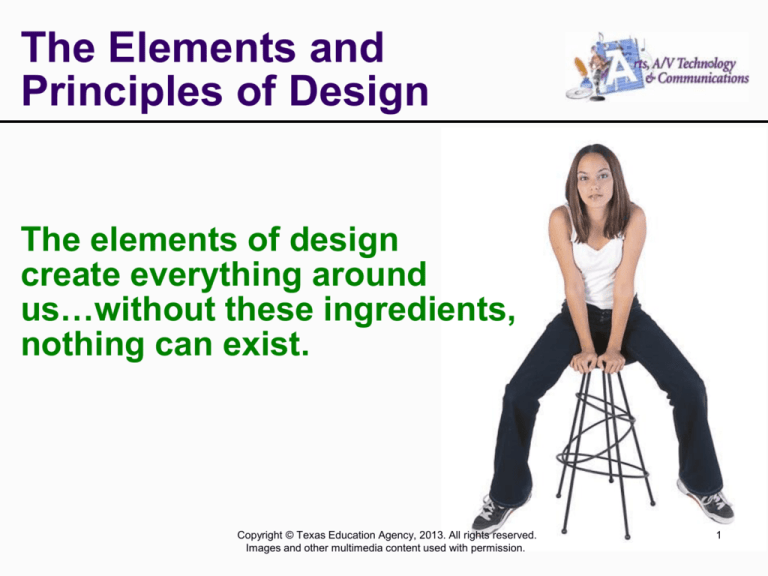
The Elements and
Principles of Design
The elements of design
create everything around
us…without these ingredients,
nothing can exist.
Copyright © Texas Education Agency, 2013. All rights reserved.
Images and other multimedia content used with permission.
1
The Elements and
Principles of Design
Memorize these eight important
Elements of Design:
Color
Line
Volume
Movement
Space
Texture
Typography
Value
Copyright © Texas Education Agency, 2013. All rights reserved.
Images and other multimedia content used with permission.
2
The Elements and
Principles of Design
Color
Also known as hue. A specific light
wavelength found in the color spectrum.
Color ranges circularly from red to yellow to
green to blue and then back to red.
Copyright © Texas Education Agency, 2013. All rights reserved.
Images and other multimedia content used with permission.
3
The Elements and
Principles of Design
Line
A line is a point in motion with
only one dimension – length.
The variables of line are size,
shape, position, direction,
number, interval and density.
Copyright © Texas Education Agency, 2013. All rights reserved.
Images and other multimedia content used with permission.
4
The Elements and
Principles of Design
Volume
A solid body composing a solid form.
Copyright © Texas Education Agency, 2013. All rights reserved.
Images and other multimedia content used with permission.
5
The Elements and
Principles of Design
Movement (or motion)
The process of changing place,
direction or orientation.
This is not animation.
However, animation
is a product of
movement added to
other elements of
design.
Copyright © Texas Education Agency, 2013. All rights reserved.
Images and other multimedia content used with permission.
6
The Elements and
Principles of Design
Space
Space is a 2D or 3D
element defined by
other elements of
design.
Copyright © Texas Education Agency, 2013. All rights reserved.
Images and other multimedia content used with permission.
7
The Elements and
Principles of Design
Texture
A technique of trying to replicate threedimensional surfaces in 2D design through
various drawing or other media technique.
In 3D, it happens by touch or visual experience.
Copyright © Texas Education Agency, 2013. All rights reserved.
Images and other multimedia content used with permission.
8
The Elements and
Principles of Design
Typography
Considered an
element in the graphic
design world.
Although type itself
consists of other
elements of design, it
becomes an element
with the constraint of
visual communication.
Copyright © Texas Education Agency, 2013. All rights reserved.
Images and other multimedia content used with permission.
9
The Elements and
Principles of Design
Value
The relative lightness or
darkness of an area
measured in a graded
scale from white to gray
to black.
Copyright © Texas Education Agency, 2013. All rights reserved.
Images and other multimedia content used with permission.
10
The Elements and
Principles of Design
The principles of design are
tools used to format the
elements of design.
The design principles are
applicable to art, architecture,
graphics, fashion, industrial
design and even writing poetry.
Copyright © Texas Education Agency, 2013. All rights reserved.
Images and other multimedia content used with permission.
11
The Elements and
Principles of Design
Memorize these eight important
Principles of Design:
Balance
Contrast
Direction
Economy
Emphasis
Proportion
Rhythm
Unity
Copyright © Texas Education Agency, 2013. All rights reserved.
Images and other multimedia content used with permission.
12
The Elements and
Principles of Design
Balance
The convergence of design
elements that appear to be
at a whole with equilibrium.
Copyright © Texas Education Agency, 2013. All rights reserved.
Images and other multimedia content used with permission.
13
The Elements and
Principles of Design
Contrast
This is the “automatic
principle”. Whenever an
element is placed into a
format, it contrasts with
other elements in the
same format in size,
shape, color or texture.
Offers variety within a
visual format.
Copyright © Texas Education Agency, 2013. All rights reserved.
Images and other multimedia content used with permission.
14
The Elements and
Principles of Design
Direction
Using movement to
create the visual illusion
of displacement.
Copyright © Texas Education Agency, 2013. All rights reserved.
Images and other multimedia content used with permission.
15
The Elements and
Principles of Design
Economy
Precision or simplicity, a principle
of most good design work.
Copyright © Texas Education Agency, 2013. All rights reserved.
Images and other multimedia content used with permission.
16
The Elements and
Principles of Design
Emphasis
Also known as dominance, this is the
hierarchy of visual importance.
One element takes precedence over others.
Copyright © Texas Education Agency, 2013. All rights reserved.
Images and other multimedia content used with permission.
17
The Elements and
Principles of Design
Proportion
A 2D or 3D element defined by
other elements of design.
Copyright © Texas Education Agency, 2013. All rights reserved.
Images and other multimedia content used with permission.
18
The Elements and
Principles of Design
Rhythm
Repetition of one or
more elements within a
visual format resulting
in harmony.
Copyright © Texas Education Agency, 2013. All rights reserved.
Images and other multimedia content used with permission.
19
The Elements and
Principles of Design
Unity
Oneness, harmony,
completeness; also
called Gestalt.
All visual elements
come together within
a format to create a
perfect whole.
Copyright © Texas Education Agency, 2013. All rights reserved.
Images and other multimedia content used with permission.
20





